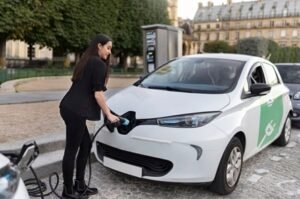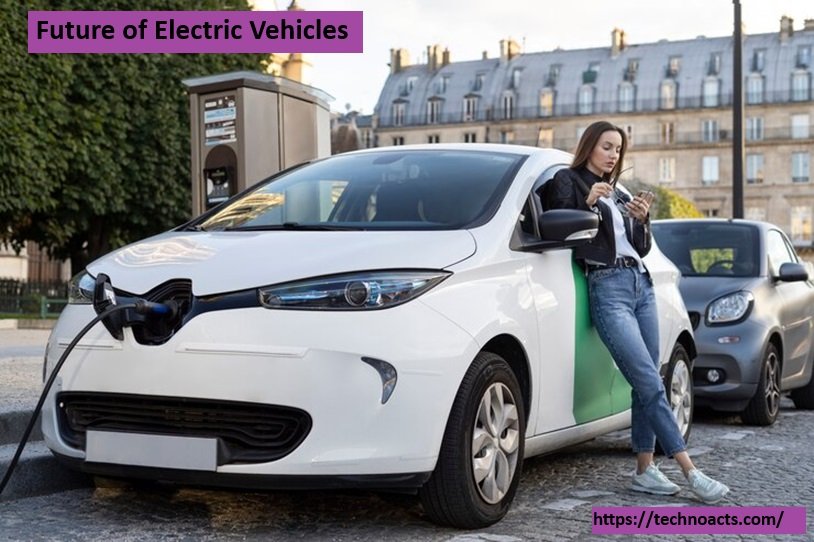Electric vehicles (EVs) have already begun to revolutionize the automotive industry, offering a cleaner, more sustainable alternative to traditional internal combustion engine (ICE) vehicles. With major advances in battery technology, charging infrastructure, and government policies encouraging adoption, the EV market is poised for significant growth. But what does the future hold for electric vehicles? This article explores the key trends and innovations that will shape the future of EV technology.
1. Advancements in Battery Technology
Battery technology is at the heart of the electric vehicle revolution. The performance, range, and cost of EVs are all heavily dependent on the batteries that power them. As such, advancements in battery technology are crucial to the future of electric vehicles.
- Solid-State Batteries: One of the most promising developments in EV battery technology is the advent of solid-state batteries. Unlike traditional lithium-ion batteries, which use liquid electrolytes, solid-state batteries use a solid electrolyte. This change offers several advantages, including higher energy density, faster charging times, and improved safety. Solid-state batteries could potentially double the range of electric vehicles while reducing charging times to just a few minutes. Companies like Toyota and BMW are already investing heavily in this technology, with the first solid-state battery-powered vehicles expected to hit the market within the next few years.
- Increased Energy Density: Ongoing research aims to increase the energy density of batteries, allowing them to store more energy in the same amount of space. This would result in longer driving ranges for EVs without the need for larger, heavier battery packs. Innovations such as silicon anodes, lithium-sulfur, and lithium-air batteries are being explored to achieve this goal.
- Cost Reduction: The cost of EV batteries has been steadily decreasing, making electric vehicles more affordable. This trend is expected to continue, driven by economies of scale, improved manufacturing processes, and advances in materials science. As battery costs continue to drop, EVs will become competitive with, or even cheaper than, their ICE counterparts, accelerating mass adoption.
- Battery Recycling and Second-Life Applications: As the number of EVs on the road increases, so will the need for effective battery recycling and second-life applications. Recycling technologies are being developed to recover valuable materials like lithium, cobalt, and nickel from used batteries, reducing the environmental impact of battery production. Additionally, used EV batteries can be repurposed for energy storage in homes and businesses, extending their useful life.
These advancements in battery technology will play a pivotal role in making electric vehicles more practical, affordable, and sustainable for the masses.
2. Enhanced Charging Infrastructure
For electric vehicles to become mainstream, a robust and widespread charging infrastructure is essential. The future of EV technology will see significant improvements in charging infrastructure, making it easier and more convenient for drivers to charge their vehicles.
- Ultra-Fast Charging: One of the most anticipated developments in EV charging is the rollout of ultra-fast charging stations. These chargers, capable of delivering 350 kW or more, can recharge an EV battery to 80% capacity in as little as 15 minutes. Companies like Tesla, Electrify America, and Ionity are already deploying ultra-fast chargers along major highways, and this trend is expected to continue, reducing range anxiety and making long-distance travel in EVs more feasible.
- Wireless Charging: Another exciting innovation is wireless charging, which allows EVs to charge without the need for a physical connection. Wireless charging technology uses magnetic induction to transfer energy between a charging pad on the ground and a receiver on the vehicle. While this technology is still in its early stages, it has the potential to make charging more convenient, especially in urban areas where space is limited.
- Smart Charging Networks: The future of EV charging will also involve the integration of smart charging networks. These networks use artificial intelligence and data analytics to optimize charging based on factors like electricity demand, grid capacity, and renewable energy availability. Smart charging can help balance the grid, reduce charging costs, and ensure that EVs are charged using the cleanest energy sources available.
- Vehicle-to-Grid (V2G) Technology: V2G technology allows electric vehicles to not only draw power from the grid but also feed energy back into it. This capability could transform EVs into mobile energy storage units, helping to stabilize the grid during peak demand periods and providing backup power during outages. As V2G technology matures, it could offer financial incentives to EV owners who participate in grid services, further enhancing the value proposition of electric vehicles.
With these advancements, the future of EV charging infrastructure will be more efficient, accessible, and integrated, supporting the widespread adoption of electric vehicles.
3. Autonomous Electric Vehicles
The convergence of electric and autonomous vehicle technologies is set to revolutionize the transportation landscape. Autonomous electric vehicles (AEVs) promise to deliver safer, more efficient, and environmentally friendly transportation solutions.
- Self-Driving Technology: Autonomous driving technology is advancing rapidly, with companies like Tesla, Waymo, and General Motors leading the way. AEVs are equipped with an array of sensors, cameras, and AI-driven software that enable them to navigate roads, avoid obstacles, and make real-time decisions. The combination of electric propulsion and autonomous driving could lead to a future where vehicles operate with minimal human intervention, reducing accidents and improving traffic flow.
- Shared Mobility: AEVs are expected to play a significant role in the future of shared mobility. Ride-hailing services like Uber and Lyft are already exploring autonomous electric fleets, which could operate 24/7 without the need for a human driver. This shift could reduce the cost of transportation, decrease the number of privately owned vehicles, and lower greenhouse gas emissions.
- Urban Planning and Infrastructure: The widespread adoption of AEVs could have a profound impact on urban planning and infrastructure. Cities may need to rethink road layouts, parking spaces, and traffic management to accommodate autonomous vehicles. In addition, AEVs could lead to the development of new business models, such as autonomous delivery services and on-demand public transportation.
The integration of autonomous technology with electric vehicles will create new opportunities and challenges, shaping the future of urban mobility.
4. Sustainability and Environmental Impact
As the world continues to grapple with climate change, the sustainability and environmental impact of electric vehicles will be a key focus. The future of EV technology will involve efforts to make electric vehicles even more eco-friendly throughout their lifecycle.
- Renewable Energy Integration: One of the most significant ways to enhance the sustainability of EVs is by integrating them with renewable energy sources. Solar, wind, and hydroelectric power can be used to charge electric vehicles, reducing their carbon footprint. Smart grids and energy storage solutions will play a crucial role in ensuring that EVs are powered by clean energy.
- Sustainable Manufacturing: The future of EV manufacturing will involve a greater emphasis on sustainability. Automakers are exploring ways to reduce the environmental impact of vehicle production by using recycled materials, minimizing waste, and adopting green manufacturing practices. Additionally, some companies are working on developing electric vehicles with fully recyclable components, further reducing their environmental footprint.
- Lifecycle Analysis: As EV adoption grows, there will be a greater focus on conducting comprehensive lifecycle analyses of electric vehicles. This approach evaluates the environmental impact of EVs from production to disposal, identifying areas for improvement. By optimizing the entire lifecycle of electric vehicles, manufacturers can ensure that EVs remain a sustainable choice in the fight against climate change.
The future of electric vehicles will be defined by a commitment to sustainability, with efforts to reduce their environmental impact at every stage of their lifecycle.
5. New Vehicle Designs and Segments
The rise of electric vehicles is also leading to innovative new vehicle designs and segments that cater to different consumer needs and preferences. The future of EV technology will see a diversification of the types of electric vehicles available on the market.
- Electric Trucks and SUVs: While early EVs were mostly compact cars, the market is now expanding to include electric trucks and SUVs. Vehicles like the Tesla Cybertruck, Rivian R1T, and Ford F-150 Lightning are redefining what electric vehicles can do, offering powerful performance, off-road capabilities, and ample cargo space. As battery technology improves, more electric trucks and SUVs will enter the market, appealing to a broader range of consumers.
- Electric Buses and Commercial Vehicles: The electrification of public transportation and commercial fleets is another significant trend. Electric buses and delivery vans are becoming more common, offering lower operating costs and reduced emissions compared to their diesel counterparts. The future will see widespread adoption of electric commercial vehicles, driven by regulations, corporate sustainability goals, and the economic benefits of electric propulsion.
- Urban Micro-Mobility Solutions: In densely populated urban areas, micro-mobility solutions like electric scooters, bikes, and compact urban EVs are gaining popularity. These vehicles are ideal for short trips and can help reduce traffic congestion and air pollution in cities. As urbanization continues, the demand for electric micro-mobility solutions is expected to grow, leading to innovative new designs and business models.
The diversification of electric vehicle designs and segments will make EVs more accessible and appealing to a wider range of consumers, driving further growth in the market.

6. Challenges and Opportunities
While the future of electric vehicles is bright, several challenges must be addressed to realize the full potential of EV technology.
- Charging Infrastructure: Although significant progress is being made, the expansion of charging infrastructure remains a critical challenge, particularly in rural areas and developing countries. Ensuring that all EV owners have access to reliable and convenient charging options will be essential for widespread adoption.
- Raw Material Supply: The demand for raw materials like lithium, cobalt, and nickel, which are essential for battery production, is expected to increase. Ensuring a sustainable and ethical supply of these materials will be crucial for the long-term growth of the EV industry. Recycling and alternative materials may offer solutions to this challenge.
- Consumer Awareness and Education: Educating consumers about the benefits of electric vehicles, including their environmental impact, cost savings, and performance advantages, will be key to increasing adoption. Automakers, governments, and advocacy groups must work together to raise awareness and address common misconceptions about EVs.
- Government Policies and Incentives: Government policies and incentives will continue to play a vital role in shaping the future of electric vehicles. Subsidies, tax credits, and emissions regulations can encourage EV adoption, while investment in research and development can drive innovation. However, as the market matures, these policies may need to evolve to address new challenges and opportunities.
The future of electric vehicles is full of promise, with advancements in technology, infrastructure, and sustainability set to transform the automotive industry. By addressing the challenges and seizing the opportunities, we can create a cleaner, more efficient, and more sustainable transportation system for future generations.




